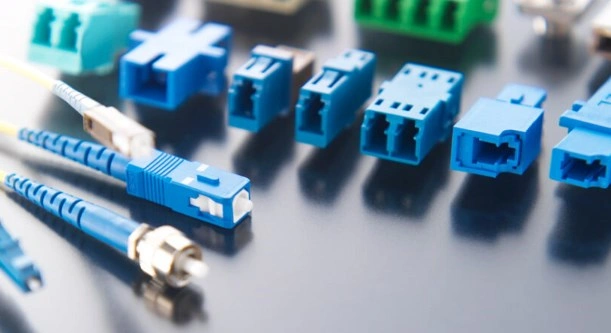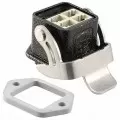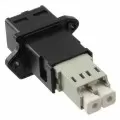OUTLINE:
The Most Comprehensive Summary of Fiber Optic Connector Types
 172
172Step into the dynamic world of fiber optic connectivity as we embark on a journey through "Exploring the Diversity of Fiber Optic Connectors."
Prepare to uncover the intricate tapestry of these essential components, driving the pulse of modern communication networks.
From the timeless elegance of industry standards to the avant-garde innovations pushing the boundaries of possibility, we invite you to witness the diversity and ingenuity of fiber optic connectors.
Whether you're a curious novice or a seasoned connoisseur, immerse yourself in the exploration of these remarkable technologies that weave the fabric of our interconnected world.

Image Source: Orbray
Detailed Information: What Is A Fiber Optic Connector
A fiber optic connector is a mechanical device designed to terminate the end of an optical fiber cable and enable it to be connected to another optical device, such as a transmitter, receiver, or another fiber optic cable.
It serves as the interface between optical fibers, allowing for the transmission of light signals between devices with minimal signal loss.
At its core, a fiber optic connector consists of several key components:
- Ferrule: This is a thin, cylindrical component made of ceramic, metal, or plastic, located at the core of the connector. The ferrule holds the optical fiber securely in place, ensuring precise alignment and minimal signal loss during connection.
- Connector Body: The connector body encases the ferrule and provides structural support for the connector. It also includes features such as alignment pins or keyways to ensure proper orientation and mating with compatible connectors.
- Connector Housing: The housing surrounds the connector body and provides additional protection for the internal components. It may feature locking mechanisms or latches to secure the connector in place once connected.
- Connector Interface: This is the part of the connector that physically connects to the corresponding interface on another device or cable. The interface may vary depending on the connector type and standards used in the industry.
What Are the Various Types of Fiber Optic Connectors
There are several types of fiber optic connectors, each with its unique design, size, and applications.
Some of the most common types include:
- ST (Straight Tip) Connector: The ST connector features a bayonet-style coupling mechanism and a cylindrical ferrule. It is commonly used in data communication and networking applications.
- SC (Subscriber Connector) Connector: The SC connector utilizes a push-pull coupling mechanism and a square-shaped ferrule. It is popular in telecommunications and data center applications due to its ease of use and reliable performance.
- LC (Lucent Connector) Connector: The LC connector is a small form factor connector with a push-pull coupling mechanism and a 1.25mm ceramic ferrule. It is widely used in high-density fiber optic installations and is ideal for space-constrained environments.
- FC (Ferrule Connector) Connector: The FC connector features a threaded coupling mechanism and a cylindrical ferrule. It is commonly used in telecommunication, instrumentation, and high-precision measurement applications.
- MTP/MPO (Multi-Fiber Push-On/Pull-Off) Connector: The MTP/MPO connector is a high-density connector that can accommodate multiple fibers within a single connector. It is commonly used in data center applications and high-speed fiber optic networks.
- SMA (SubMiniature version A) Connector: The SMA connector is a screw-type connector commonly used in high-frequency applications such as fiber optic test and measurement equipment, as well as some industrial and military applications.
- MT-RJ Connector: Mechanical Transfer Registered Jack Connector is a miniaturized fiber optic connector. Its design is similar to RJ-45 connector, so it is also called "mini connector". The design of MT-RJ connector makes it excellent in high-density connection environment because its small size can achieve more connections in a limited space. MT-RJ connector is commonly used in high-speed networks and fiber-to-the-home (FTTH) applications.
- MU connector: Miniature Unit Connector is another common fiber optic connector. Its design is similar to SC connector, but smaller in size, so it is also called "micro connector". The design of MU connector makes it excellent in high-density connection environments because its smaller size allows more connections to be made in a limited space. MU connectors are commonly used in high-speed networks and fiber-to-the-home (FTTH) applications.
- CS connector: The Compact Small-form-factor is a miniaturized fiber optic connector. Its design is similar to the LC connector, but smaller in size, so it is also called an "ultra-miniature connector". The design of the CS connector makes it perform well in high-density connection environments because its smaller size allows more connections to be made in a limited space. CS connectors are commonly used in high-speed networks and fiber-to-the-home (FTTH) applications.
The Difference of these Types of Fiber Optic Connectors
The various types of fiber optic connectors differ in terms of their design, size, coupling mechanism, and applications.
Here's a brief overview of the key differences between some of the most common types:
Here's a brief overview of the key differences between some of the most common types:
1. ST (Straight Tip) Connector:
Coupling Mechanism: Bayonet-style coupling mechanism (twist-on/twist-off).
Ferrule Size: Typically 2.5mm.
Applications: Commonly used in data communication and networking applications, such as LAN (Local Area Network) connections.
2. SC (Subscriber Connector) Connector:
Coupling Mechanism: Push-pull coupling mechanism (push to connect, pull to disconnect).
Ferrule Size: Typically 2.5mm.
Applications: Widely used in telecommunications, data center connections, and high-speed internet connections.
3. LC (Lucent Connector) Connector:
Coupling Mechanism: Push-pull coupling mechanism (similar to SC but smaller).
Ferrule Size: Typically 1.25mm.
Applications: Ideal for high-density installations, such as data centers and fiber-to-the-desk (FTTD) applications.
4. FC (Ferrule Connector) Connector:
Coupling Mechanism: Screw-type coupling mechanism.
Ferrule Size: Typically 2.5mm.
Applications: Commonly used in telecommunication, instrumentation, and high-precision measurement applications.
5. MTP/MPO (Multi-Fiber Push-On/Pull-Off) Connector:
Coupling Mechanism: Push-pull coupling mechanism for multiple fibers (up to 12, 24, or 72 fibers).
Ferrule Size: Typically 12.5mm.
Applications: High-density connections in data center environments, such as for backbone cabling and parallel optical links.
6. SMA (SubMiniature version A) Connector:
Coupling Mechanism: Screw-type coupling mechanism.
Ferrule Size: Typically 2.5mm.
Applications: Commonly used in high-frequency applications, such as fiber optic test and measurement equipment, as well as some industrial and military applications.
How To Choose a Fiber Optic Connector for you
Selecting the right fiber optic connector involves a thorough assessment of various factors to ensure seamless integration and optimal performance.
Understanding your application's specific requirements, including transmission speed, bandwidth needs, and signal loss tolerance, is essential.
Compatibility with existing infrastructure is crucial, ensuring alignment with equipment interfaces and addressing space constraints, particularly in high-density environments.
Ease of installation and maintenance is vital. Choose connectors with user-friendly coupling mechanisms to facilitate quick and secure connections, reducing installation time and minimizing errors.
Review performance specifications, such as insertion loss, return loss, and durability, to ensure reliable data transmission and longevity.
Balancing cost with performance is key. Consider both initial purchase price and additional expenses associated with installation, maintenance, and future upgrades to maximize value.
Seek guidance from fiber optic experts or reputable suppliers to make an informed decision that meets your application requirements effectively.
By evaluating these factors carefully, you can confidently select the right fiber optic connector for seamless connectivity and reliable performance in your communication system.
How Do you Connect Fiber Optic Cable to the Connector
To connect a fiber optic cable to a connector:
Prepare the cable by stripping the outer jacket and cleaning the fibers.
Cleave the fibers with precision.
Insert the cleaved fiber into the connector ferrule, ensuring proper alignment.
Secure the fiber with epoxy adhesive or mechanical crimp.
Polish the connector ferrule for a smooth end face.
Inspect the connection for cleanliness and quality.
Repeat for multifiber connectors, if necessary.
Protect the connection with caps or dust covers.
Conclusion
"Exploring the Diversity of Fiber Optic Connectors" has shed light on the multitude of connector types available, each serving unique purposes in the realm of fiber optic communication.
From the widely-used ST and SC connectors to the space-saving LC connectors and high-density MTP/MPO connectors, the array of options reflects the versatility and adaptability of fiber optic technology.
Understanding the differences between these connectors is essential for making informed decisions in various applications, whether in telecommunications, data centers, industrial settings, or beyond.
As technology evolves and demands for high-speed, reliable connectivity grow, continued exploration and understanding of fiber optic connectors will remain crucial for building robust communication networks.
Embracing this diversity empowers engineers, technicians, and enthusiasts alike to harness the full potential of fiber optics in shaping the future of communication.

Disclaimer: The views and opinions expressed by individual authors or forum participants on this website do not represent the views and opinions of Chipsmall, nor do they represent Chipsmall's official policy.

share this blog to:



